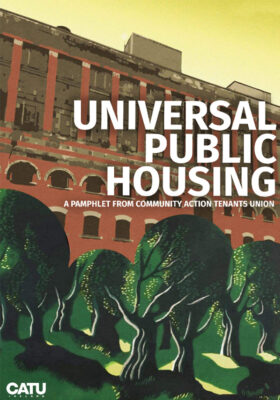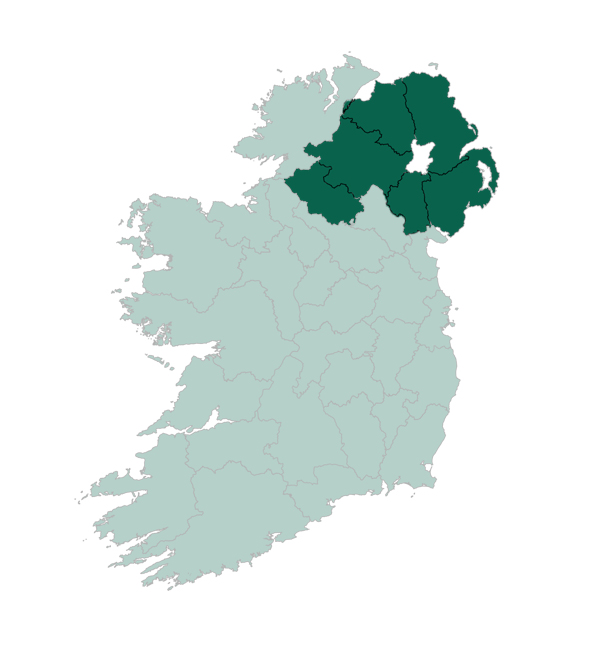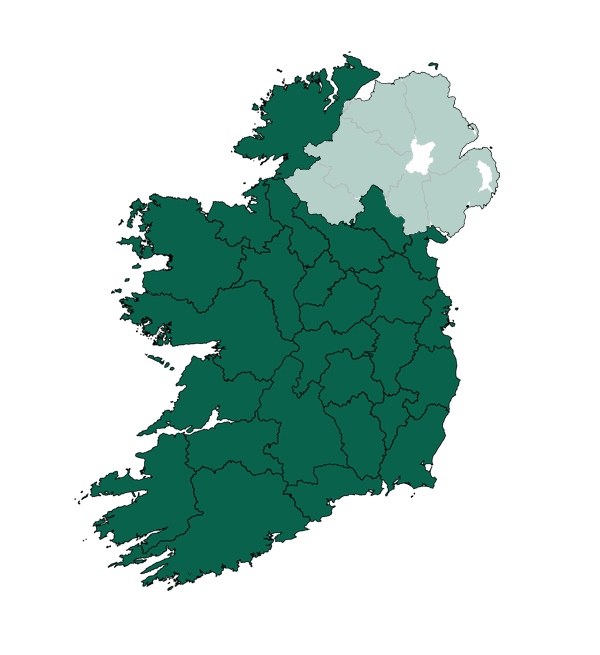Across the island of Ireland there is a growing housing crisis. In the 26 counties the policies of neoliberalism have led to the worst homelessness crisis since the foundation of the state. In the six county region of Northern Ireland the crisis may not be as acute in official terms but homelessness and housing stress is growing, meaning that housing is on the same crisi-driven trajectory as elsewhere on theis island (Smyth, S. 2020).
BACKGROUND: WHY DO WE NEED A CHANGE IN OUR HOUSING SYSTEM?
The default of position for governments on this island (of all political persuasion) over the past number of decades has been to allow the private market to provide housing solutions, with the experience that those with little or no income have no choices but to live in cramped, unhealthy, unsuitable and precarious housing.
However, this experience now extends itself to those formerly deemed as ‘well paid’ with large swathes of the population submerged perennially in high rents and no hope of home ownership. Gentrification and sectarianism is also having a detrimental effect on communities across Ireland.
CATU Ireland believes in a model of housing for all when it comes to the housing question, founded in opposition to the private housing market’s profit motive and lack of accountability.

STATISTICS

SIX COUNTIES
60% increase in those officially recognised as being homeless in the last five years with almost 20,000 presenting as homeless in 2019 (McClements, F., 2020).
By December 31st, 2020, the social hosuing waiting list stood at 42,665, with 26,387 seen to be in “housing stress” (Butterley, L. 2021).
Rents have risen by 19% between Q1 2013 and Q2 2020 (Housing Executive, 2020).
There are more than 20,000 empty homes (Monaghan, J., 2016)
STATISTICS
7,991 people were homeless in the week of the 24th – 30th May 2021. This figure includes adults and children (Focus Ireland, 2021). This is missing the ‘hidden homeless’ – people living in refuges, Direct Provision, institutions, or those forced to couch-surf or live in overcrowded homes with several generations of the same family – so the actual homeless firgure is much higher (Fitzgerlad, C., 2017).
Number of homeless families has increased by 232% since July 2014 (Focus Ireland, 2021).
Almost one third of people in emergency accomodation are children (Focus Ireland, 2021).
26 COUNTIES

61,880 households were assessed as being qualified for, and in need of, social housing support as of 2 November 2020 (Focus Ireland 2021). Those who are in receipt of HAP, rent supplement, or similar schemes, are marked as no longer in need of social hosuing support, despite the issues with this schemes, meaning the real figure of those in housing distress is much higher (Department of Housing, Local Government and Hertiage, 2021).
Standardised average rents are now €1,320 a month, with Dublin signifantly bringing up the average (Residential Tenancies Board, 2021).
There are somewhere between 92,251 and 183,000 vacant dwellings (excluding holiday homes) (Fitzgerald, C., 2021)
Large scale landlords own more than 31,200 housing units. Ireland’s biggest residential landloard, IRES REIT, owns more than 2,500 apartments in Dublin alone with annual rental income of €36m in 2017 (McCárthaigh,. S., 2019)
OK, BUT WHERE WILL THE MONEY COME FROM?
The government in the 26 counties budgeted to spend more more on Housing Assistance Payment (HAP) and related subsides to private landlords than it did for local authorities to build social housing last year.
WHAT IS ORGANISING?
People use the term organising in many different ways. By organising we mean reaching out to people where they live, even if we may not know them initially, and getting them to join a disciplined, structured organisation, so we can use our strength as tenants and working-class communities.
€800 Million in public money which is currently used to shore up the private landlord-driven market via HAP and other schemes, could instead fund state-owned, public housing (mcDermott, S., 2020). The figures alone would build an estimated 2600 to 3200 typical three-bedroom public homes using the Department of Housing’s own figures (Burke-Kennedy, E., 2020).
The government has also started long-term leasing arrangements for social housing from private developers. In Dún laoghaire, one development of 34 apartments will cost the public €25 Million to rent long-term as social housing only for it to ultimately in private hands (Kelly, E., 2021). this would build 80 to 100 homes the state could own instead, using the same figures above!
Furthermore the combined figure of between 100,00 – 200,00 empty homes across the island could be seized and turned into public housing.
Similarly, we can nationalise large landlords like IRES REIT who make make a huge profit off the backs of tenants. The Deutsche Wohnen & Co. Enteignen campaign in Berlin shows there can be massive public support for this.
Fourthly, a portion of the initial costs could be paid through taxation, particularly properly taxing multinational corporations and the wealthy. for example, the 26 county state has fought not to take €13 Billion in back taxes from Apple in the European courts (Brennan, J., 2020); a figure which alone could build at least 43,000 to 52,000 public homes.
Finally, in terms of new income streams, the state can borrow at a significantly cheaper rate than the private sector. Meaning that if new housing is a priority, it can be done both in a more cost-effective way (as less funds are going to line a developers pockets) and with a greater initial loan.
While this is not as straightforward in Stormont for obvious reasons, the Housing Executive exists as a very impressive piece of infrastructure that could provide universally accessible public housing if funded properly.
All of this would fund the construction of new housing, but the housing will pay back itself! Unlike the development of private rental accommodation, which is meant to be a cash cow forever, the model of universal public housing aims to pay back any initial build cost and leave society with the social good of a public home.
As universal public housing is meant for all incomes with different rents, those who earn more will contribute what they can and effectively subsidise those on lower incomes (National Economic and Social Council, 2014). Once built costs are repaid, any surplus can go into the funding of new social housing.
Ultimately holding onto valuable public land will result in a much greater revenue stream for future housing in the long-term than transferring it tp private developers ever could.
In summary there are many avenues that could be used to build or provide public housing:
- Using existing money that is propping up the private market and boosting sham ‘social housing’ statistics.
- Seizing empty properties.
- Taking common ownership of properties owned by large landlords.
- Taxing wealthy individuals and tax-evading multinational corporations.
- State borrowing.
We know that if the state wanted to, it could provide funds for any number of expensive projects tomorrow, yet we languish in a seemingly permanent housing crisis. We need to build public housing now!
WHAT CAN I DO TO GET MORE INVOLVED?
CATU is building an all-Ireland campaign for universal public housing to tackle the housing crisis.
Join CATU, catuireland.org/join, and get involved in this campaign to stop the selloff of public land and build public housing! We will be planning actions of all sorts to combat the privatisation of public goods, to insert a right to housing in the constitution, and getting out in our communities to raise awareness of universal public housing. Get involved and have your voice heard in the fight!
On top of that you can:
- Bring it up to your family, your workplace, your neighbours.
- Bring a motion to your trade union branch to support it.
- Lobby your elective representatives.
SOCIAL, CULTURAL & ECONOMIC BENEFITS OF UNIVERSAL PUBLIC HOUSING
Historically, the building of social housing removed the scourge of tenements and landlordism, leading to the stabilisation of communities, and played a role in countering emigration from Ireland.
Outside the obvious improvements for tenants; affordable housing with rents tied to income, security of tenure, higher quality accommodation etc., there are several associated social & cultural benefits to schemes of universal public housing.
For instance, it allows for more deeply rooted communities that are less likely to be torn apart by evictions. It would give generations of families the ability to live nearby and not be forced to separate because of unaffordable rents.
Universal public housing should also be built with the idea of community in mind. It affords us an opportunity to build amenities directly into spaces where people live, and directed by the communities that live there.
Finally a programme of state housing building would provide an opportunity for high-quality, well-paid jobs in both construction and maintenance and allow for skill-sharing and training in the process.
As the state has increasingly moved away from funding social housing it has become stigmatised as a form of housing provision. We want to see beautiful public housing that everyone wishes to live in!
A NOTE OF TERMINOLOGY:
CATU Ireland is an all-Ireland union of tenants, those in precarious living situations, and more. When talking about housing across the 2 different jurisdictions on the island of Ireland, it can be useful to distinguish between them alongside describing the crisis in general terms. It is a fact that the language used to describe these distinctions is not value free. For this pamphlet we have opted to distinguish between the jurisdictions known as the Republic of Ireland and Northern Ireland primarily using the terms ‘26 counties’ versus ‘6 counties’ respectively, as it describes the objective geographical situation, regardless of any other association. This is not to denigrate any political tradition on the island of Ireland and the stylistic choice in this pamphlet does not indicate a general stance of the union on the nomenclature.

